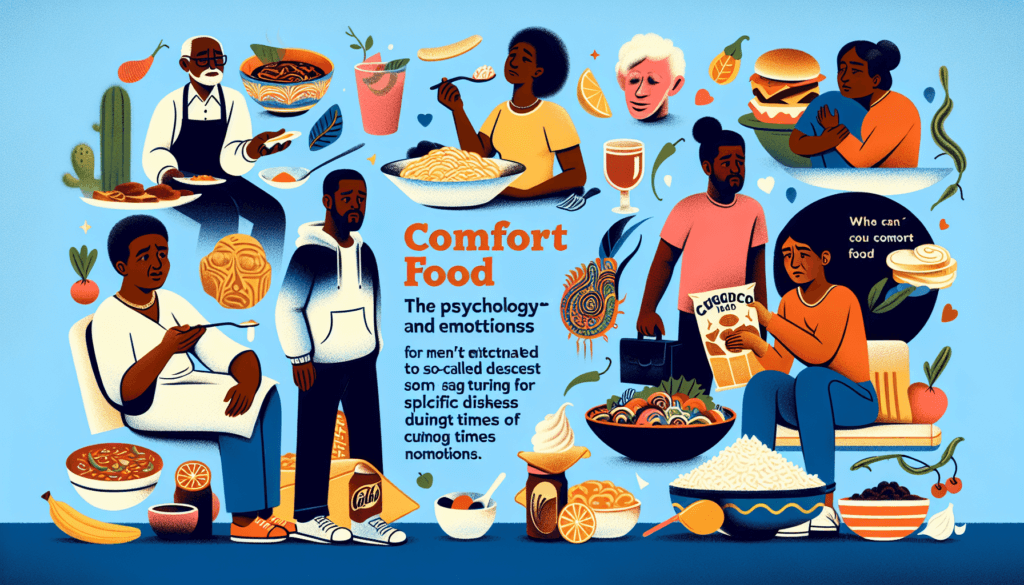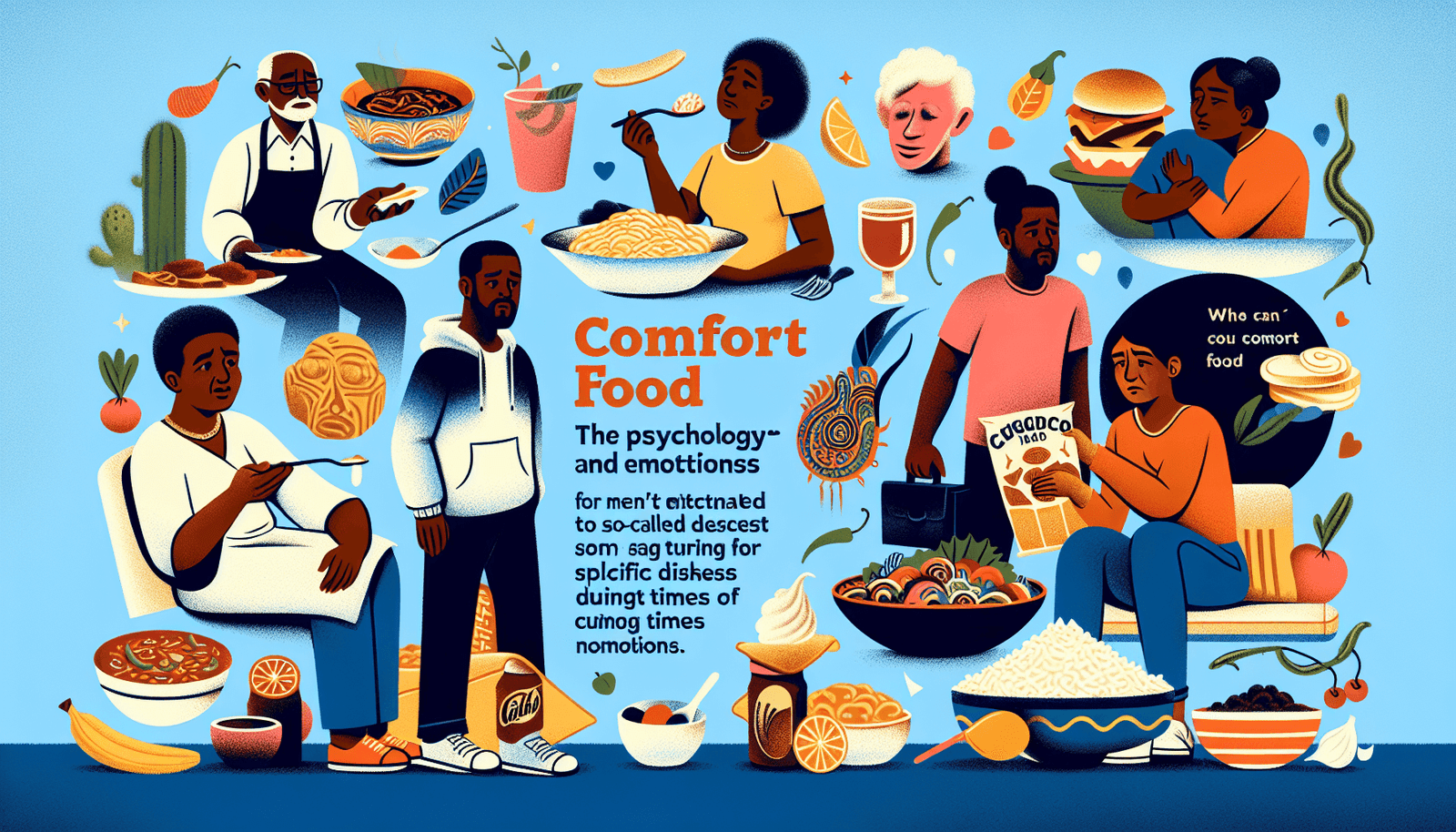Imagine a world without comforting bowls of mac and cheese or warm slices of apple pie; it’s hard to fathom, isn’t it? But have you ever wondered why certain dishes earn the title of “comfort food”? In this article, we will explore the origins and psychology behind these edible delights that bring solace to our hearts and warm our souls. From the scientific explanations of their effect on our brains to the cultural and emotional significance they hold, prepare to delve into the fascinating world of why some foods are deemed as comforting.

Definition of Comfort Food
Comfort food is a term used to describe certain foods that provide a sense of emotional well-being and comfort. These foods often have a nostalgic or sentimental value, and they can evoke feelings of warmth, happiness, and security. Comfort food is highly subjective and varies from person to person, as it is influenced by personal, cultural, and regional factors. It is important to note that comfort food is not solely defined by its nutritional value, but rather by the emotional satisfaction it provides.
Comforting and Emotional Connection
The main characteristic of comfort food is its ability to provide a comforting and emotional connection. When you consume these foods, you often feel a sense of relief and comfort, similar to receiving a warm hug or finding solace in a familiar place. Comfort food has the power to soothe and uplift your mood, providing a temporary escape from the stress and challenges of daily life. These foods have the ability to elicit positive emotions and create a sense of emotional well-being.
Psychological Reasons
Comfort food choices are deeply rooted in psychology and are influenced by various psychological factors. Understanding these reasons can shed light on why certain foods hold such a special place in our hearts and minds.
Associations with Childhood
Many comfort foods are deeply rooted in our childhood memories. These foods often remind us of the comfort and security we felt when our caregivers prepared these dishes for us. The taste, aroma, and texture of these foods can transport us back to a time when life felt simpler and safer. Reconnecting with these childhood favorites can evoke feelings of nostalgia and provide a sense of emotional comfort and stability.
Nostalgia and Familiarity
Comfort foods often hold a sense of nostalgia and familiarity. They are associated with specific events, celebrations, or traditions that are deeply ingrained in our memories. The mere thought of these foods can bring back memories of family gatherings, holiday festivities, or special occasions. The familiar taste and smell of comfort food trigger a sense of comfort and security, making us feel connected to our roots and providing a source of solace in times of stress or distress.
Emotional Release and Stress Relief
Comfort food has the ability to provide emotional release and relieve stress. The act of consuming these foods can trigger the release of feel-good chemicals in the brain, such as endorphins and oxytocin, which can help alleviate negative emotions and promote a sense of calm and well-being. In times of stress or emotional turmoil, turning to comfort food can serve as a coping mechanism and provide temporary relief from emotional distress.
Biological Factors
The appeal of comfort food goes beyond its emotional and psychological effects. Biological factors also play a role in our preference for these foods.
Brain Chemistry and Neuropeptides
Comfort food consumption triggers a cascade of chemical reactions in the brain. When you consume these foods, the brain releases neuropeptides, which are chemicals that regulate emotions and mood. These neuropeptides, such as endorphins and oxytocin, create a sense of pleasure and reward, reinforcing the association between comfort food and positive emotions.
Serotonin and Dopamine Release
Certain comfort foods are known to increase the production of serotonin and dopamine in the brain. These neurotransmitters are often referred to as “feel-good” chemicals, as they regulate mood, pleasure, and reward. The consumption of comfort food can temporarily boost serotonin and dopamine levels, leading to a sense of satisfaction, happiness, and contentment.
Sociocultural Influences
Comfort food choices are influenced by sociocultural factors, such as family traditions, cultural norms, and social bonding.
Family and Cultural Traditions
Comfort food is often deeply intertwined with family and cultural traditions. These foods are passed down through generations, becoming a part of our cultural heritage. The act of preparing and sharing these foods with loved ones can strengthen family bonds and create a sense of belonging. Comfort food serves as a reminder of shared experiences and traditions, connecting us to our roots and cultural identity.
Social Bonding and Connection
Comfort food has the unique ability to foster social bonding and connection. Gathering around a table to share a comforting meal creates a sense of togetherness and unity. The act of cooking and serving comfort food to loved ones can be an expression of love, care, and nurture. In times of celebration or hardship, the presence of comfort food can provide a source of comfort, support, and solidarity within a community or social group.

Preference for High-Fat and High-Calorie Foods
It’s no secret that many comfort foods are high in fat and calories. There are several reasons why we are inclined to seek out these types of foods when seeking comfort.
Satiety and Pleasure
High-fat and high-calorie foods are known to provide a greater sense of satiety and pleasure compared to healthier alternatives. The rich and indulgent flavors and textures of these foods can activate pleasure centers in the brain, resulting in a heightened sense of satisfaction. The physical sensation of feeling full and content can contribute to the overall comfort and emotional well-being experienced when consuming comfort food.
Evolutionary Perspective
From an evolutionary perspective, our preference for high-fat and high-calorie foods can be traced back to our ancestors. In times of scarcity, foods rich in fat and calories were essential for survival. Our genetic predisposition to seek out these energy-dense foods may explain why they continue to hold such appeal today. This preference for high-fat and high-calorie foods may have served as an adaptive advantage in the past, but in today’s food-abundant environment, it can pose challenges to maintaining a healthy balance.
Impact of Food Advertising
Food advertising plays a significant role in shaping our perception and preference for comfort foods.
Marketing Strategies
Food companies use various marketing strategies to promote their products as comfort foods. These strategies often involve associating their products with positive emotions, nostalgic experiences, and feelings of comfort and well-being. Through carefully crafted advertisements, packaging, and branding, companies tap into our emotional connection with comfort foods, making their products irresistible and desirable.
Association of Comfort with Specific Products
Food advertising often associates specific products with the concept of comfort food. Whether it’s a brand of ice cream, a certain type of chocolate, or a particular fast food item, these products become synonymous with comfort. The repeated exposure to these advertisements can create strong associations in our minds, making us more likely to turn to these specific products when seeking comfort.

Regional and Cultural Variations
Comfort foods exhibit significant variations across different regions and cultures.
Comfort Foods Across Different Cultures
Comfort foods vary greatly based on cultural and regional influences. For example, in the United States, macaroni and cheese, apple pie, and fried chicken are considered classic comfort foods. In Italy, pasta dishes like lasagna or spaghetti carbonara evoke feelings of comfort. In Japan, a warm bowl of ramen or a plate of tonkatsu can bring about a sense of emotional well-being. These cultural variations reflect the diversity of experiences and traditions associated with comfort food.
Climate and Seasonal Influences
The climate and seasonal variations also play a role in determining comfort foods. In colder regions, warm and hearty dishes like stews, soups, and casseroles are often considered comforting. These foods provide warmth and nourishment, making them particularly appealing during colder months. In contrast, in warmer climates, refreshing and lighter dishes may be preferred as comfort foods. The availability of seasonal ingredients also influences the types of comfort foods enjoyed in different regions.
Gender Differences in Comfort Food
Gender stereotypes and emotional eating tendencies can influence the types of comfort foods preferred by individuals.
Gender Stereotypes and Food Choices
Societal gender stereotypes often play a role in shaping food preferences. For example, it is commonly believed that women are more inclined to turn to sweet comfort foods like chocolate or ice cream, while men may prefer savory comfort foods like pizza or burgers. These stereotypes can influence individual choices, but it is important to recognize that food preferences and comfort food choices are highly individual and can vary regardless of gender.
Emotional Eating Tendencies
Emotional eating tendencies can also influence gender differences in comfort food choices. Women are more likely to engage in emotional eating, which involves turning to food as a way to cope with negative emotions or stressful situations. This tendency may lead women to seek out comfort foods more frequently as a means of emotional comfort and stress relief. However, it is important to note that emotional eating is not exclusive to women and can occur in individuals of any gender.

Nutritional Concerns
While comfort food provides emotional satisfaction, it is important to be mindful of the potential nutritional concerns associated with excessive consumption.
Emotional Eating and Weight Gain
The indulgence and overconsumption of comfort foods can contribute to weight gain and other health issues. Emotional eating, when not balanced with mindful eating habits, can lead to excessive calorie intake and an unhealthy relationship with food. It is important to be aware of emotional triggers and develop healthy coping mechanisms that go beyond relying solely on comfort foods.
Healthy Alternatives
It is possible to enjoy the comfort of food while also maintaining a balanced and nutritious diet. Exploring healthier alternatives to traditional comfort foods can help strike a balance between emotional satisfaction and nutritional well-being. For example, substituting ingredients, such as using whole grains instead of refined grains or opting for lean proteins, can make comfort foods more nutritious without sacrificing taste or comfort. Additionally, finding non-food-related activities that provide comfort and emotional well-being, such as engaging in hobbies, spending time with loved ones, or practicing self-care, can help reduce reliance on food as the sole source of comfort.
Conclusion
Comfort food holds a special place in our hearts and minds, providing a sense of emotional well-being, nostalgia, and familiarity. The choice of comfort foods is influenced by psychological, biological, sociocultural, and gender-related factors. While comfort food can bring temporary relief and comfort, it is important to be mindful of nutritional concerns and strive for a balanced approach to consumption. By understanding the reasons behind our cravings for comfort food and exploring healthier alternatives, we can continue to enjoy the emotional satisfaction of comfort food while nurturing our overall well-being.



